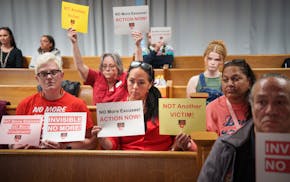Opinion editor's note: Strib Voices publishes a mix of guest commentaries online and in print each day. To contribute, click here.
•••
"Ooh!" My mom gasps from a few steps ahead of me on the trail we are hiking in the Chequamegon-Nicolet National Forest in northern Wisconsin. I hurry forward and spot the vibrant orange and white of a chicken of the woods mushroom peaking through the greens and browns of the fallen leaves and undergrowth.
My mom is giddy. This is her first time finding an edible mushroom in prime condition that she feels confident identifying. Its soft, meaty flesh will be a delightful addition to our dinner once we get back to the campsite where the rest of our family is napping in the midday heat. We cut a few of the fan-like fronds to take with us, leaving the majority of the mushroom for the bugs, squirrels and other hikers, and continue on our way.
Since I started foraging around four years ago, for me, this moment encapsulates the value of collecting edible plants and fungi from the outdoors for food or medicine. The joy of finding these natural gifts not only directly connects us to the forest through the nutrients we gain, but also builds a sense of responsibility to take care of these spaces so they can continue to nourish us.
The Minnesota Department of Natural Resources is currently reworking its foraging guidelines in response to the surge in outdoor recreation during the pandemic. Its proposals have included a bag limit on how many mushrooms, nuts or berries could be harvested per person per day or a permitting system to collect the amounts of these resources necessary for preservation. However, their suggestions have been met with backlash because they have neglected to include the input of the people most impacted by these changes: foragers.
As an outdoor educator and member of the Minnesota Mycological Society, the foraging community's calls to participate in creating data-based regulation got me wondering: What does the science say about sustainable foraging? While the articles and studies I perused yielded few definitive answers, they led back to the same conclusion: Partnering with foragers to create regulation is necessary to promote accessible recreation and long-term sustainability.
The creation of state-managed conservation areas has preserved Minnesota's abundance of stunning nature. However, this history also includes the dispossession of Indigenous lands and the separation of traditional practices, like foraging, from the management of these spaces. Restricting access to state-managed land for foraging and other traditional uses without input from the community continues these exclusionary practices. It also limits the potential to maintain and build a relationship with these spaces that could enable people to become active participants in protecting these spaces.
In contrast to fishing guidelines, which are supported by annual data gathered by the DNR, there is not a comparable source of information on the abundance of common edible species or the impact that foraging has on them. Foragers are often the ones who know the most about these trends through years of experience in the woods. Most of the foragers I've met are excited to protect these species and give back to the areas that support them through activities like invasive species removal or trash pick up. Pairing the DNR's knowledge of the broad scope of the public lands in Minnesota with the place-based expertise of experienced foragers would allow us to create policies in line with the evidence applicable to these areas.
Reworking these regulations allows us to craft usable, logical guidelines that let foragers continue connecting to the land without unintentionally harming these communities. When I think about the transformative power of foraging, I remember the excitement on my mom's face on that Wisconsin trail and her renewed joy every time she tells the story. What might we create if we see the increased interest in foraging as an opportunity to inspire people to become stewards of the areas that feed them, physically, mentally and spiritually rather than a threat? We say the way to a person's heart is through their stomach, so why not give our stomachs a chance to guide us to a more sustainable relationship with the land?
Grace Sommers lives in Minneapolis.
Editorial Board Cheers & Jeers: Online tools are transparent when the air isn't

Brehm: Alpha News deserves respect from its competitors
Opinion: Partnering with Minnesota's foragers is essential to creating sustainable regulations
